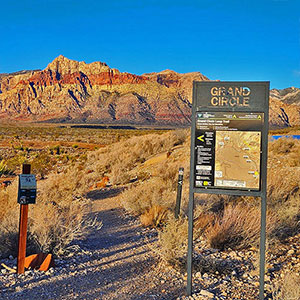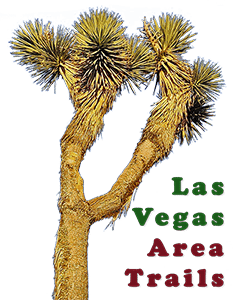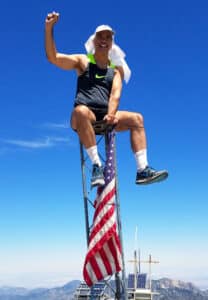









































































The Grand Circle Loop is a 11.3-mile trail that makes a grand circle of Red Rock Canyon. It’s great general overview of Red Rock Canyon and its surrounding wilderness areas. As you traverse the Grand Circle Loop you will see every major location in Red Rock Canyon. In addition, you will receive an immersive experience of the desert landscape along with developing important navigation skills in this environment. The Grand Circle Loop is a relatively safe introduction to Red Rock Canyon. The loop is well marked (except for 4 areas, which I will describe below). And, you’re never more than a half-mile from the well-traveled Red Rock Scenic Drive, so there are numerous exit points along the way.
During this Grand Circle Loop overview of Red Rock Canyon, I will describe the major destinations in Red Rock Canyon and point out the surrounding wilderness areas, along with access routes to these areas, including:
And then, before you know it we’re back at the Red Rock Canyon Visitor Center, our starting point.
In addition, in the video, I describe my wilderness navigation strategy and gear for this type of terrain.
If you watch the video and take the Grand Circle Loop before visiting any of the destinations in Red Rock Canyon, you’ll have a big picture perspective along with how to travel light and stay safe as you go!
All the maps on this website are integrated with the Google Maps platform, so you can click on any map and get driving directions to any location on the site.
In short, you will take I-215 to the Charleston Blvd. Exit and head up Charleston Blvd. toward the mountains. You’re now on Hwy 159. After passing through the residential area, you will continue past the first turn-off on the right (Calico Basin) and take the second turn-off to the right which is Red Rock Canyon. Be sure to have a reservation if you will arrive at 8am or later.
The Grand Circle Loop Trailhead is located just to the left (West) of the Red Rock Canyon Visitor Center. You’ll need to park in the public parking area and then walk through the smaller employee and handicapped parking area. You’ll know when you have arrived at the trailhead because there is a large sign.
I take the loop in the clockwise direction. Traveling in this direction beginning at sunrise will result in every wilderness area you approach throughout your time on the Grand Circle Loop being brilliantly lit up by the sun.
One downside of traveling in a clockwise direction is that it appears the directional signs on the Grand Circle Loop may be more clear in the counterclockwise direction. However, here are the four places you may get off track:
Knowing these 4 sketchy places along the Grand Circle Loop will enable you to successfully take the loop in a clockwise direction always facing brilliantly lit up scenery all along the loop. Otherwise, the Grand Circle Loop is very well signed, perhaps the best signed trail in Red Rock Canyon.
Now, a more detailed description of destination points in Red Rock Canyon and surrounding wilderness areas you will see from The Grand Circle Loop:
Those brightly colored mountains along the West side of Red Rock Canyon actually form their own unique wilderness area: The Rainbow Mountain Wilderness. These Jurassic Era frozen sand dunes are calico colored. The reds are formed from iron leaching up from the soil while they were still sand dunes.
The Rainbow Mountains stretch from their Northern end in the Willow Spring area in Red Rock Canyon all the way to their Southern end at Highway 190 in the Mountain Springs area.
Some of the familiar peaks in the Rainbow Mountains along the West end of Red Rock Canyon are:
Due to their make-up, the Rainbow Mountains are a world rock climbing destination. In order to scale the Rainbow Mountains from below, you will need advanced rock climbing skills, gear and the ability to navigate vertical rock faces (Class 4, 5 and above level of climbing). One exception is Juniper Peak, which can be summited using only class 2 and 3 skills (class 2 is walking; class 3 is scrambling over rocks and boulders which require use of your hands). For this reason, only a few visitors to Red Rock Canyon have summited the Rainbow Mountain peaks.
Just getting to the summit approaches involves navigating boulders, ledges and seemingly impenetrable walls of brush in the access canyons, three of which have trailheads located on the Red Rock Canyon Scenic Drive:
However, there is another, class 2 and 3 route to the summits of the Rainbow Mountain peaks that totally avoids the difficult canyons below and class 4, 5 and above cliff climbing…
The other, easier, class 2 & 3 path to the Rainbow Mountain summits is to summit them not from below, but from above, as strange at that may seem!
Access from above the Rainbow Mountain summits is by way of The Rainbow Mountain Upper Crest Ridgeline. If you look closely at the Rainbow Mountains, you’ll notice a ridgeline that runs the entire length of the Rainbow Mountains just to the West and above many of the summits. In fact, Mt. Wilson, the highest Rainbow Mountain summit at 7,071 feet is only about 200 feet higher than the Upper Crest Ridgeline behind, or West of its summit.
Now, there is a drawback to summiting the Rainbow Mountains from the Upper Crest Ridgeline: There are long distances involved, so you might want to be in or close to marathon conditioning! Here are the main areas on the Upper Crest Ridgeline along with links to my adventures there:
Ice Box Canyon lies between Buffalo Wall and Bridge Mountain. Though Ice Box Canyon is one of the most popular destinations on the Red Rock Canyon Scenic Drive, I have yet to explore that canyon as of the writing of this article. Will do this soon!
So, I’ll talk about canyon navigation here. As mentioned above, navigating the lower canyons in the Rainbow Mountains requires dealing with seemingly impenetrable walls of brush, along with large boulders and ledges. But there are additional considerations. When wet, the boulders and ledges become as slick as an ice-skating rink. Stay away from the canyons within 24-48 hours after the last rain. Then, there is the season: Summer can bring temperatures exceeding 110 degrees in the canyons and Winter can bring snow and ice in the upper canyons making the surface even slicker than after a rain storm.
This leaves the best seasons for these canyons as Fall and Spring, but these seasons also have considerations. In the Fall, those wall of brush are at their thickest and highest. And, no one has been helping create pathways through the brush during the hot Summer months. In the Spring, the creeks in the canyons are at their highest from Winter runoff from the mountains above. Take your pick. Fall and Spring are the best time of years for navigating the canyons.
Pine Creek Canyon lies between Bridge Mountain and Juniper Peak. Pine Creek Canyon has a North and South branch, divided by the spectacular Mescalito Pyramid formation. The North branch becomes pretty sketchy when the rock climber access trails give out at Mescalito Pyramid. The South branch appears to be easier to navigate to the upper canyon area. I have not gone beyond Mescalito Pyramid in either branch of Pine Creek Canyon. There’s a great Pine Creek Canyon loop trail that gives access to both North and South branches.
Juniper Canyon lies between Juniper Peak and Rainbow Mountain. Like all the canyons in the lower Rainbow Mountains, Juniper Canyon can get a bit sketchy in the brush area. However, this does not prevent this access point to Juniper Peak from being the most popular with class 2-3 climbers. It can become a bit like an LA freeway on weekends in the Fall and Spring, and that final summit approach may be like the line-up at the DMV! On the good side, you’re never far from other climbers, which will help you stay on track!
Oak Creek Canyon lies between Rainbow Mountain and Mt. Wilson. As with Pine Creek Canyon, Oak Creek Canyon has a North and South branch. As of this point in time, Oak Creek Canyon appears to be the most promising access to the mid Rainbow Mountains Upper Crest Ridgeline from the Red Rock Canyon area. I have explored the North Branch of Oak Creek Canyon. Again, brush, boulders and ledges. The South Branch looks more promising. The South Branch splits off about a third of the way up the canyon.
Willow Spring, located between White Rock Mountain and the Northern tip of the Rainbow Mountains, is a well-developed picnic area with assess to a number of trailheads both easy and more difficult. There is even a well-signed interpretive trail for children. In addition, you will find Red Rock Canyon’s most diverse vegetation zone in and around the Willow Spring area.
This is a 5-mile loop around the base of White Rock Mountain that features a great trail running surface. On the White Rock Mountain Loop you’ll traverse a very diverse climate zone from pine forests on the North side to desert brush on the South Side. Finally, there is a beautiful spring, Willow Spring, on the South side of the loop not far from the trailhead (taken in a clockwise direction). I took the White Rock Mountain loop counterclockwise, but there is no best direction on this loop.
Those cliffs you see on the North end of Red Rock Canyon are the Keystone Thrust Cliffs in the La Madre Mountains Wilderness. The easiest access to the upper cliff line is by way of La Madre Springs.
La Madre Springs is located on the Northeast area of White Rock Mountain. When you’re on the White Rock Mountain Loop, take the split-off to La Madre Spring. The springs flow year-round, but Spring is the best season to visit. Above the springs there is an old miner’s cabin. Behind the cabin is the easiest access point to summit the Keystone Thrust from Red Rock Canyon.
I’ve mentioned the easiest access point to summit the Keystone Thrust from Red Rock Canyon. There are some other, more difficult access points:
From The Keystone Thrust Trail at the White Rock Mountain upper parking area. The trail is well marked and takes you along the base of the Keystone Thrust Cliffs.
From the Sandstone Quarry area, take the Turtlehead Peak trail past the Calico Tanks trail split, over a ridge and back down into the main wash you have already crossed once. Only this time, instead of crossing the wash to continue on the Turtlehead Peak trail, head up the wash. In a mile or two the wash will split. Take the right split which leads you over into the upper Calico/Brownstone Basin. Head for the saddle (notch) between El Padre Mountain on the left (West) and La Madre Mountain on the right (East). Continue find your way to the upper Keystone Thrust cliffs between El Padre and La Madre Mountains.
Take some time to visit the historic quarry area where 10-ton (20,000lb) sand stone blocks were quarried from the white rock hillside to be used for construction. The quarry was in operation from 1905-1912 when it was no longer cost effective to transport the blocks. Quite a few blocks remain as well as the area they were quarried.
The two main trailheads from the Sandstone Quarry are:
As mentioned above, this summit has one of the most spectacular views of Red Rock Canyon and its surrounding areas. To get a better view you would need to be on the Keystone Thrust cliffs, on a summit in the Rainbow Mountains or on The Rainbow Mountains Upper Crest Ridgeline. Those alternate spectacular views will require much longer distances (10-20 mile round trips) and some difficult navigation. Turtlehead Peak gives a spectacular view in a short 5-mile round trip. If you get lost on this sometimes sketchy trail, just stay above the Northern base of the main wash heading for the saddle at the top of the wash on the way up or for the lower opening on the way down. You’ll reconnect with the trail as long as you keep this big picture navigation in mind. The sight of other hikers on this popular trail will also help keep you on track.
Take this trail to it’s upper end on your first visit there, noting alternate routes to the right and the left. On your second visit you can be more creative, making additional discoveries on the alternate routes.
There are many cross-over points from Red Rock Canyon to the neighboring Calico/Brownstone Basins. Here are seven:
Petroglyphs make their appearance on the Grand Circle Loop at a large boulder about mid-way down the Calico Hills section. The only indication that there are petroglyphs here is a warning sign that basically says, “Don’t deface history”. That warning caused me to take a closer look at a large more horizontal slab at the base of the boulder. There were quite a collection of petroglyphs in the area which are shown in the video and slideshow on this page. To learn more about Southern Nevada petroglyphs and their meaning view the 74-page Master of Arts Degree in Archaeology thesis “Valley of Fire Petroglyphs: A New Perspective On An Old Idea” by Eric Pacl. Further exploration in the Calico Hills and other red rock formations in Red Rock Canyon would certainly reveal more petroglyphs. Willow Spring is another area with petroglyphs in Red Rock Canyon.
You’ll find this unmarked route originating from the Red Springs Desert Oasis parking area. If you look carefully at the calico hills from the parking area you’ll see a diagonal line from the low point (South) at the Red Springs Desert Oasis to a high point (North) at the summit of the Calico Hills. Take a pair of binoculars with you the the parking area and watch for people ascending and descending the Grand Staircase route in order to be more certain about the pathway. There are no trails and a lot of scrambling over boulders, but it’s fun!
This is a loop that circles the base of the lower Calico Hills. It’s easier to stay on course and find the upper cross-over point if you begin at Red Springs Desert Oasis and take the loop in a counterclockwise direction. On the Red Rock Canyon side of the Calico Hills you’ll find yourself on the Red Rock Canyon Grand Circle trail. Follow the pathway up around the Southern base of the Calico Hills to find yourself back at Red Springs Desert Oasis.
In this adventure video on this page I take time to give my best wisdom for desert navigation including route choices, things to avoid, assessing the weather and water flow and simple but essential gear.



Return often to experience one new adventure each week! From the home page scroll to “Most Recent Adventures“. More about David Smith…
The trail adventures on this website require proper conditioning, preparation and safety precautions. There are many factors beyond our control including weather conditions, unstable ground, loose rocks, insects and snakes, people you may encounter, your own level of physical conditioning, the potential of getting lost just to mention a few. While this site offers guidance, helpful tips, direction and training, the reader assumes full responsibility for whatever may occur during their trail adventure. Have fun and be safe!